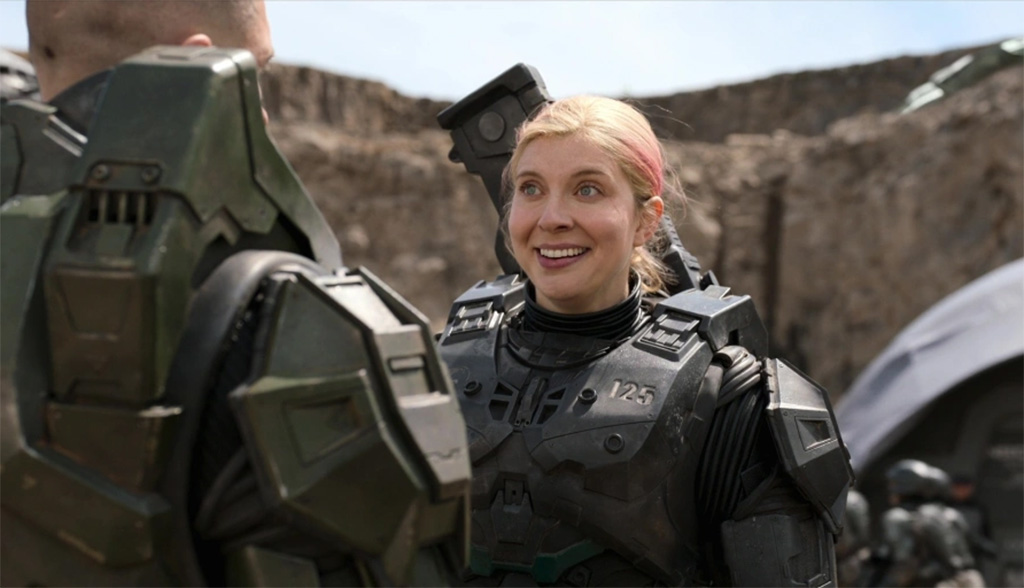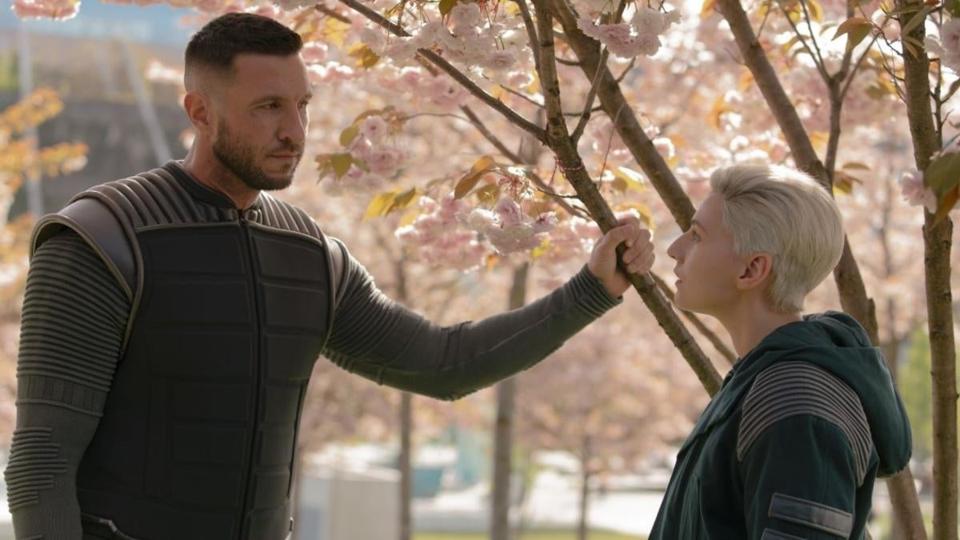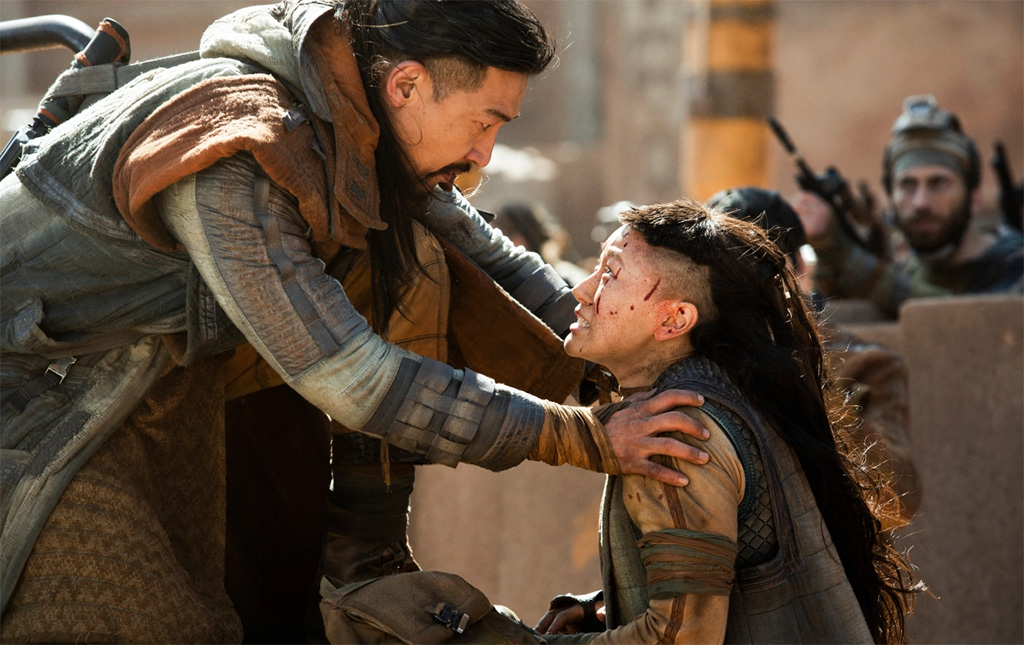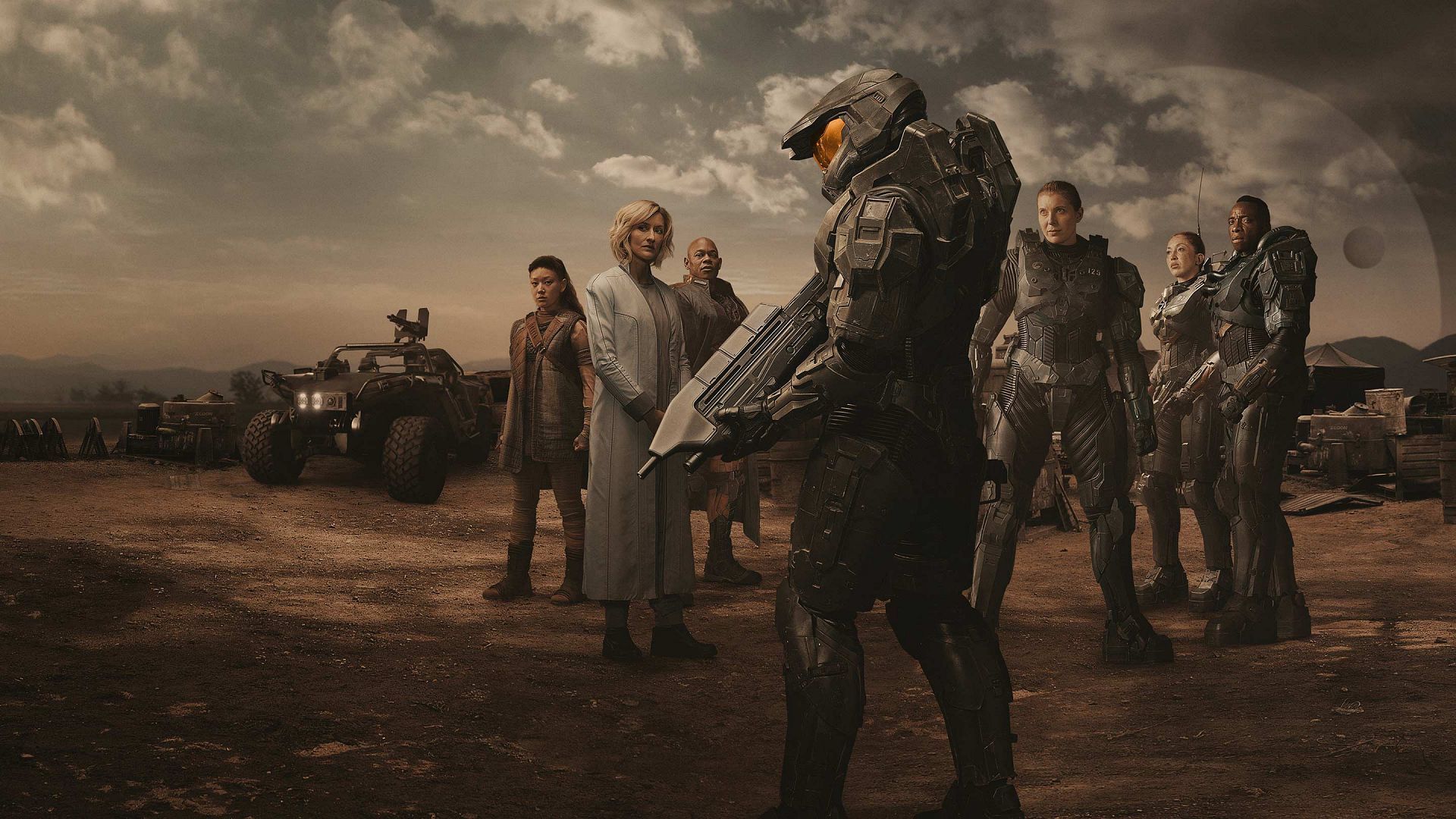Whatever nuggets of gold Halo: The Series had littered throughout, they were completely undermined by unfocused writing that resulted in a middling, misguided, but not completely unenjoyable affair.
The super soldier known as Master Chief and his Silver Team of Spartans discover a strange and mysterious artefact while defending a colony from an alien force called The Covenant… now had the show stuck to that basic premise we might have had something truly fun.
The season finale aired a couple of months ago yet I set this review aside mainly because I’ve been busy with other things but also I wasn’t sure if I wanted to throw my opinions atop the pile of negative and toxic discourse, getting lumped in with them in the process. Mainly because I don’t agree with the hyperbole that this is the “worst video game adaptation ever” or even that it’s “bad”, it’s just that I’m so frustrated by how “not good” the end result is.
I’ve also spent a little bit of time trying to analyse my own biases, as a fan of the games from the very beginning, of course I’d have my own expectations. But also I’m only familiar with a small portion of the extended media that expands the lore (books, comics, web series, etc), some of it I like more than others. But there’s over 20 years worth of that so I had little to no problem with the showrunners admitting they were doing their own thing, that it wasn’t set within the canon and universe we’re accustomed to. If Marvel Studios can distil decades worth of comics into the highly popular and enjoyable “Cinematic Universe” of theirs then I’m game for this series to attempt similar.
Unfortunately, not everyone is very good at distilling.

It’s incredibly frustrating because there’s actually a few things to like about this show but it’s dragged down by either clumsy execution, lack of follow through, or other derivative ideas (which is ironic as Halo the video game is a collection of derivative sci-fi ideas in the first place). There are good ideas and cool moments that work in isolation but are undermined by an inability to make the disparate elements work together. On top of that there appears to be a desire to ape more popular shows of a similar nature, taking their tropes and mistaking them for compelling writing, without understanding why those shows actually worked.
I always aim to be constructive in my criticisms yet I’ve been struggling with how to present this review mainly because it’s so easy to fall down the hole of “it sucks” with my list of things I liked and didn’t like because it’s not always a case of “thing good, thing bad” but often more along the lines of “thing good until it stops being good.”
Might just be time to get it off my chest….so SPOILERS FROM THIS POINT FORWARD…
From the sets to the costumes and props to the visual effects, Halo is a good looking show for the most part. Most of the CG works in bringing to life all the alien Covenant characters ranges in quality but at the very least its serviceable and often very cool. The production design is also well done, a lot of it translating the designs from the game, with the USNC looking appropriately grey and utilitarian, the outer colonies are colourful and vibrant, and the Covenant sets are out of this world and monastic.

Many of the action set pieces are exciting and rather fun to watch. A lot of the choreography is well done and while the references to the games can be rather on-the-nose they are broad enough to be amusing to long-time fans without alienating newcomers. In fact, the opening action sequence in the very first episode was really quite spectacular and without it it may have not held my attention otherwise.
The cast are good, or at least doing what they can with the material they’ve been given, although I will admit some of that is difficult to parse because at times the writing is… well, I’ll get to that. Natascha McElhone makes for a great younger version of Dr Catherine Halsey, the creator of the Spartan programme. She does well to portray the character’s darker (if more obvious) impulses and works as the series’ sort-of-antagonist. Jen Taylor reprises her role from the games as the A.I. Cortana, being the cheeky and delightful offsider when needed.
People have gotten this incorrect but it’s is actually game lore that Miranda Keyes is Haley’s daughter (which they’ve maintained here) but they’ve got her more in proximity with her estranged mother. Olive Gray does a great job in portraying Miranda as the naïve and less experienced, yet brilliant, UNSC scientist (instead of the ship commander like in the game). I like Danny Sapani’s take on a more conflicted and perhaps regretful Captain Jacob Keyes and father to Miranda. And both Natasha Culzac and Bentley Kalu do remarkably well with what little they are given as Spartans Riz and Vannak respectively.
However, the standout is Spartan Kai-125 (Kate Kennedy) as a member of Silver Team. She and Miranda work well opposite each other and Kai ends up being the more compelling character out of anyone as she rediscovers her humanity in parallel to the Chief.

I’m a little torn when it comes to Pablo Schreiber as Master Chief John-117, not because he’s not good, he definitely wears that armour well and is a rather imposing and charismatic presence, it’s just that the writing let him down… quite severely. Similar with Kwan (played by Yerin Ha) the daughter of rebel leader of the Madrigal colony, and Makee (Charlie Murphy) as a kidnapped human brainwashed by the Covenant (to mirror Chief’s backstory). On paper all their premises had major potential and while the three of them are giving it their all, they are ultimately undermined by the unfocused writing.
To simply claim “bad writing” is an unhelpful and trite cliché online these days and in most cases it’s difficult to elaborate with character limits but there are a few main issues where the writing fails the show…
The first is that the story is unfocussed and results in too many story threads running parallel instead of the one that fans should/would be interested in and therefore the audience’s attention is spread too thin (granted, parallel arcs can be in service of the main story and other shows handle this rather well – I’ll get to that later). We’re not just following Chief’s exploits but also Halsey’s ambitions, Miranda’s need to prove herself, Kai’s self discovery, Kwan’s journey to liberate her people, and Makee’s struggle are just a few of these threads. But only a few are in service of the main narrative and the others seem to simply peter out. Or at least it appears that way because this first season isn’t a complete narrative.
As I said, it’s possible to maintain interest in multiple story arcs and other shows have proven this (even though many of them do so with diminishing returns). HBO’s Westworld is a great example where not only multiple character arcs are utilised but different time periods too, which causes some confusion but the showrunners lean into that to create a mystery for the audience to unravel. Going with a Paramount+ show and Star Trek: Discovery is a closer example, however, each season is more or less a self-contained narrative where all the important threads culminate in a resolution by season’s end.

The problem with Halo is that season 1 is merely the first act of a larger story. While there is build up and a culmination of something in the final episode, there’s no satisfying conclusion to anything because the showrunners want to stretch it out for another season (which was already “greenlit” before the premiere not because they were confident in season 1 but because that’s just how the scripts were structured), such is the way of streaming shows these days. Which is why a show called “Halo” still hasn’t arrived at the titular place yet (for the fans, this is still before the “Fall of Reach” kind of stuff going on). So while the various story threads may work on paper or even in isolated execution, they fail because by season’s end there’s nothing to resolve them or connect them to the larger narrative. This is meant to be a cliffhanger but instead it creates dissatisfaction.
Some of those threads work better than others, like the aforementioned Kai’s character arc, where she removes the inhibitor and starts to feel things again, discovering herself, and making a connection with Miranda Keyes. There’s a rather clever set up and payoff in regards to Dr Halsey’s final fate. And Makee being kidnapped as a child by the Convenant, brainwashed, and used as double agent mirrors John’s own backstory. But these ideas don’t exist because they want to tell a compelling story, they exist because they want to emulate other popular prestige shows.
People have assumed that Makee’s existence in this show is because it’s easier to not have to render CG alien characters all the time and still give a face to the enemy to interact with. I would suggest that it’s also because the show wanted its own version of Daenerys Targaryen. From the bleach-blonde hair to the slight build, to the unnecessary bit of nudity for a simple changing of clothes as well as that love scene, even bringing in the guy that created the Dothraki language to invent Covenant dialogue for her to speak. It becomes painfully obvious that instead of organic storytelling, the writers were taking inspiration for ideas elsewhere without understanding why those elements worked for those shows.
It’s also why Kwan Ha’s entire sublot does not work. Not only does it ultimately have zero to do with the core story but Kwan spends most of the series elsewhere away from the main narrative in her own b-plot, encounters some strange mystical tribes people that send her on a silly vision quest, and then that entire subplot is forgotten. Nothing about it works, nothing about it is interesting let alone compelling despite the actor’s best efforts. The UNSC trying to quell a rebel uprising is part of Halo lore (background lore, stuff in the books, not the games) but this feels more like an attempt to emulate The Expanse. They wanted to be more like Game of Thrones, like Westworld, instead of being Halo. While we’re at it, the backstabbing and political intrigue in the UNSC only seems to be present because “serious and mature”. The story comes the a pointless and screeching halt during these moments.
It’s the Master Chief we’re all interested in.

And that in itself is frustrating because, setting aside this is a different Chief than we’re used to, the writing is rushed and just not very confident. His journey to discover his origins and the truth of him becoming a Spartan is a great idea, however, it speeds through that journey by making him fall for Makee and ending up in bed together because “mature storytelling”. Now I’m no prude, you could have anyone in that show get their freak on, but you have to remember that both John and Makee are both emotionally-stunted victims of unresolved childhood trauma. So to have them in a poorly-shot love scene is all sorts of ick. Not only that, having Cortana watch John and Makee doing like they do on Discovery Channel THROUGH JOHN’S EYES was not the denouement they thought it would be.
I mentioned earlier that Kai’s character arc was the much more appropriate fit for Chief (in fact it made Kai the more interesting character), whether you want to have the connection John develops be between him and Keyes, or him and Kai, or even with Cortana (which makes the most sense), that makes for a much better and more interesting story for him. Instead we end up with a horny teen prone to tantrums (yes, he makes some bad choices by following his dick). Again, these ideas may be good in isolation but they don’t work in combination because the writers were spending more time copying things they thought made other shows good instead of focusing on telling their own story.
Sticking to lore and canon was never a requirement for me. As I keep repeating ad nauseum the Marvel Cinematic Universe is a great distillation of decades worth of comics and I wanted that for Halo because the books can be rather dense and tend to work around the games. But not everyone is very good at the distilling and streamlining process. There are moments that are canon and familiar to fans, such as Miranda being Halsey’s daughter, but the rest feel haphazard. John’s “recruitment” isn’t as heavy a revelation as one would expect it to be, also the creation of Cortana feels rushed and lazy. Chief being given the “chosen one” type of narrative does sort of come from the games (Halo 4 and The Librarians revelation). Here it’s a way for him to be the one that finds the Halo weapon through interacting with the ancient and mysterious artefacts, a rather boring and trite trope.

Time to address the elephant in the room as it also informs so much else in the show but most critics of the series seem to get wrong. The claim is that Master Chief never takes his helmet off but that’s actually not true. In the games he seldom takes his helmet off and the few times that he does, the running gag is that the audience never sees his face (he takes his helmet off at the end of the first game but it happens as the camera is panning out of a window, he is seen putting on new armour at the beginning of Halo 2, and at the end of the fourth game there is a cutscene after the credits where Chief is finally getting his well-deserved rest, takes his armour off and – if you’re playing in “legendary” level – you get a tiny glimpse of his visage heavily zoomed in and obscured by shadow).
There are two things about this show that work against continuing that gimmick, and the first is deliberately writing scenarios that require John to take his helmet off or be out of armour altogether. It’s not unreasonable for him to be out of the suit when he’s in the barracks where he sleeps, or even have his helmet off when on base away from the action, it makes sense. The problem is that a lot of the story happens on base or in the barracks so he’s constantly out of the armour. Even when there is a reason for him to keep the suit on, the writers always find ways for him to be out of it. Former Spartan Soren (Bokeem Woodbine – who is actually pretty good but seemingly wasted) insists that John take his armour off before entering his home. This then undermines a potentially good bit of character building regarding Soren’s son being awed by John (instead of a big “robot” in his home, it’s just a tall guy in a bumpy wetsuit he’s supposedly gotten attached to and it ends up not being too effective).
Another moment with Soren is completely ruined as the joke would’ve worked much better had Chief kept his helmet on…
The other problem is that John seems to take his helmet off even when he’s in potentially dangerous environments. One would assume that if you’re on an unknown planet or even in a soon-to be hostile situation you would keep the helmet on not just to protect yourself but to take advantage of all the whizzbang science stuff in your heads up display. But no, Chief seems to take his helmet off at every opportune moment, even SECONDS after the enemy has just retreated from battle so the camera can see him do the soap opera stare before cutting to commercial.
There is also an important and dramatic moment toward the end of the first episode where Chief takes his bucket off for the first time in the show to get Kwan on side. It’s actually a good moment but is undermined by him not putting it back on when they are in danger again as well as the problematic optics of this tiny little Asian girl only trusting this hulking super soldier because he looks “normal” or “white passing”.
So John ends up carrying his helmet around everywhere and it looks very awkward as he traipses around with it in hand. As a Halo cosplayer myself I know exactly how awkward that looks too and it ruins the imposing stature of this character. That’s further watered down by how visible he is to the regular enlisted who appear to share the same base on the Planet Reach. It’s always been implied in the games that most UNSC soldiers have never seen a Spartan in real life before but this show has them sharing the same rec hall and walking the same hallways, being easily recognised. That could have worked but it no longer makes the Spartans special in the eyes of these characters.

There is a part of me that wishes they had maintained the running gag for the series and filmed it in ways you never see Chief’s fact (low camera angles, framing is face out of shot, foreground objects obscuring his head). I realise that’s silly but it would at least add some mystique and interest back to the character. Unfortunately, a lot of filmmakers are stuck in a very old and outdated notion that audiences “need” to see a character’s face in order to relate to. This completely ignores that we’re a generation that not only imbued our non-human-faced toys with personalities when we were kids but also that The Mandalorian proved first-hand you can make a stoic and faceless character compelling and build up to a reveal.
I can understand why people have enjoyed the show… which sounds disingenuous but what I mean is there are things that I enjoyed in this series too, however, the good parts don’t make a good whole in this instance. It’s why I don’t consider this show to be “bad” but more so squandering the few good choices it makes. It either misses every shot it takes or drops the ball altogether.
It’s something I’ve noticed that affects a lot of similar shows but it’s not entirely unreasonable to surmise that not everyone is capable at adapting, distilling, or even telling long-form stories. Even the shows that are widely-popular and compelling seem have diminishing returns: the much-reviled final season of Game of Thrones had no book to reference, Discovery seems to be repeating itself and flying on fumes after a first season that kicked the franchise back into gear, and no one seems to know that the fourth season of Westworld is currently on. Hell, even the much-lauded Marvel shows on Netflix began to run out of puff after their respective (and great) first seasons.
To round off, there are a few other more minor elements that bewilder me. While the Spartan armours look great onscreen, I do think it’s odd that they are all very dark and Chief is the only one in greenish camo while the others are navy or midnight blue. You could rationalise it’s because he’s team leader but even that doesn’t work aesthetically. Probably a symptom of filming in a pandemic but the universe feels a touch claustrophobic especially the plant Reach. Even the desolate alien planets feels like rock quarries half the time. Also, while I appreciate “colour blind casting” and efforts to create diversity, people must be more aware of the ramifications in their writing. When a Covenant “Jackal” character is adapted to be a “crazy” human, the optics of such a change may not be palatable.

I’m annoyed at how much I dislike this show because I really was rooting for it over the naysayers who hadn’t seen a single frame of it yet. And that first episode gave me some hope. I don’t doubt there was genuine and sincere effort put behind a lot of the production of Halo but they were really let down by the writing and squandered the show’s potential by not focussing on telling its own narrative and instead looked elsewhere, not for inspiration but for easy solutions and tropes in place of compelling narrative. It’s also too drawn out to be any sort of satisfying.
The complete first season of Halo is available on Paramount+
If you enjoyed this review then please consider contributing to my tip jar at: ko-fi.com/oldtrenchy

